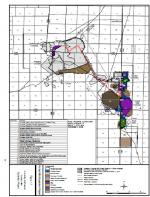 | |
The Western Shoshone have been in a constant struggle with the United States Government and Barrick Gold Corp. over the mining taking place on sacred Shoshone homelands in Nevada. The conflict focuses on two main questions: who has the rights to the land and what are the environmental impacts of mining.
Most recently, this conflict has centered around the proposed expansion of the Cortez Mine, already one of the largest mines in the United States. The Cortez Mine, which is located within the spiritual center of the Shoshone people, Mt. Tenabo, threatens to dewater sacred springs and streams. The proposed expansion project was for an 850 acre pit to be used for cyanide-heap leaching process and will cause serious irreversible damage to the sacred Shoshone homelands.
On December 3, 2009 an injunction was granted by the Ninth Circuit Court of Appeals on behalf of the tribal plaintiffs against the expansion plans for the Cortez Mine; located in Beowawe, Nevada. The court ruled that the Bureau of Land Management (BLM) violated the National Environmental Protection Act, based upon the impacts the mine has on the water, air quality and other natural resources. While the injunction was important it was unfortunate that the court did not ultimately side with the tribal plaintiffs, and the decision only temporarily stopped the mine expansion project.
The BLM recently completed their Supplemental Environmental Impact Statement (SEIS) and there has been much controversy surrounding their new information. The biggest issue is that of dewatering Mt. Tenabo and the effect that will have on the land and the natural springs and streams. The BLM is claiming that the mining company will only be removing about 20 gallons per minute, and this small amount will not affect the replacement sources. The Shoshone people and their allies believe that no matter how small the number of gallons per minute may be it is still adding to the growing water deficit and that is unacceptable. Much of the drawdown, which is a change in water level based upon background conditions, from the Cortez Mine will not recover and as a result will forever change the natural springs and streams. The mitigation plan for this situation is to bring in water from other sources when the streams dry up. The Shoshone people strongly oppose this plan. The proposed solution is inadequate because it demonstrates a lack of understanding and respect for the Shoshone culture and the sacred nature of water.
The Western Shoshone Defense Project (WSDP), a non-profit organization working on behalf of the Shoshone people, understands that at this point it will not be able to stop the Cortez Mine current expansion project. However, the WSDP wants to bring forth changes in the current accepted mining practices. The effects of the Cortez Mine are severely damaging to the Mother Earth and the WSDP seeks to effect change.
The Western Shoshone Defense project and its allies intend on taking the BLM to court over the SEIS in order to bring about a change in the current accepted mining practices. It is understood the court will not stop the mine expansion project, but the WSDP is hoping to convince the judge that this new SEIS does not prove that the BLM is doing a better job. The WSDP hopes that this case will be a springboard for raising the bar on how mines operate especially in terms of their use of water. Even though the mines only operate for a short time, 30 years or so, the impact they have on the environment will be felt forever. The United States needs to assess the future impact its decisions will have on the environment and then re-evaluate current policies and practices. |